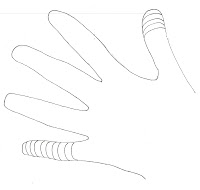Note: This newsletter is a little early this month, as I'm taking a group of students on a travel sketching cruise to Alaska. I won't be back until after the first of September. Hope you enjoy this month's topic!One of the easiest parts of the body to draw is the hand. That's because we can see one while we draw with the other. In my beginning drawing class I have asked students to draw their hands using blind contour--looking only at the object and then drawing it without looking at the paper. It's hard, and most people get a kick out of what appears on their paper. With enough practice, one can get rather good at drawing blindly.
 Then I ask everyone to trace (the only time I allow my students to trace anything) their hand and draw contour lines (like ones used on a topographical map), as illustrated here. Eventually, your hand looks like it's wrapped up mummy style, but it also shows how the hand begins to form right before your eyes.
Then I ask everyone to trace (the only time I allow my students to trace anything) their hand and draw contour lines (like ones used on a topographical map), as illustrated here. Eventually, your hand looks like it's wrapped up mummy style, but it also shows how the hand begins to form right before your eyes. Finally draw your hand as you would usually. I like using cross-hatch marks when I do this. It's fun to use all sorts of drawing marks to create a hand.
Finally draw your hand as you would usually. I like using cross-hatch marks when I do this. It's fun to use all sorts of drawing marks to create a hand.As everyone knows I see shapes inside objects first. With the hand I see several rectangles, connected by balls (knuckles) and then all connected to a big square (the palm). I was recently reading one of Andrew Loomis' books, Drawing the Head and Hands, which you can download at http://illustrationisland.files.wordpress.com/2010/01/andrew-loomis-drawing-the-head-hands.pdf. He uses the same idea, using first the rectangle, which turns into cubes. Below are several of his illustrations of hands:
| Notice how he uses cubes to define fingers. |
| The palm and back of the hand |
Drawing hands is a fun activity, one which you can do anytime, anywhere because you always have that free hand to serve as your model. Why not do a study or two of them this coming month.
Next Month: Drawing from photographs
Fall Classes at Glastonbury Studios Start Week of September 11, 2011
Pre-registration required. Seating is limited.
- Tuesday evenings (7-9) Drawing: People and Perspective
- Wednesday mornings (10:00 to 12:30) Sketching (Landscape)
- Thursday evenings (7-9) Acrylics (Abstract, Collage & More: beginning to intermediate)
Travel sketching plans for 2012
Workshop payment due October 1st
Mediterranean Cruise: Looks like we have room for four more people for the cruise, planned for May 22-28, 2012. For more information go to the trip blog.








